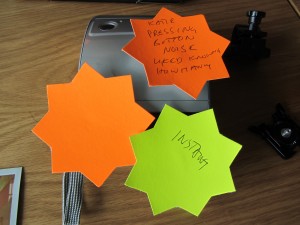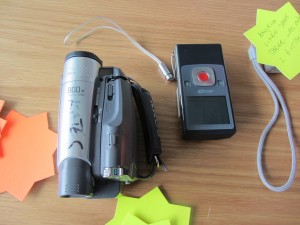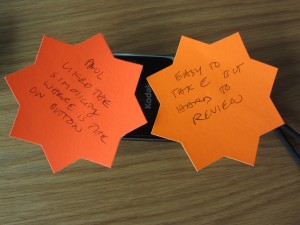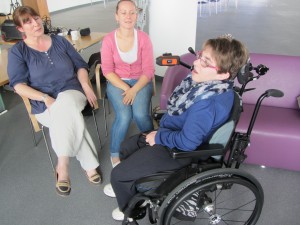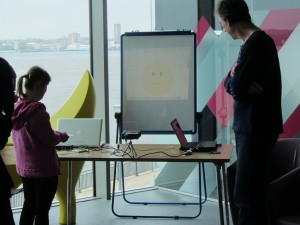We had the first interactive sensory workshop today with the Access to Heritage Forum at the Museum of Liverpool.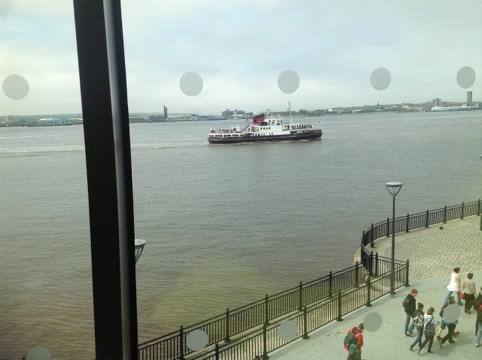
The day went really well it was great to meet everyone and discuss how we will work together on the research project as participative researchers and how the group may document vists and workshops with various cameras we tried out in the workshop. 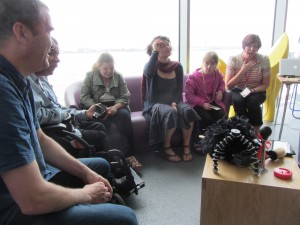
Some of the group had worked on the Sensory Trail at Speke hall, we talked about the objects and workshops from then. We started by wondering what interactive sensory objects could be. We looked at some everyday objects exploring how we use them and what was the effect of using them. 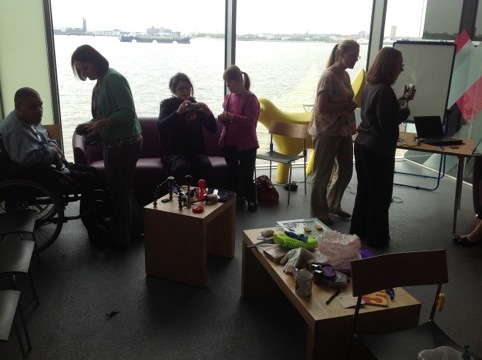
The objects included a fan, a feather boa, some gloves with rubbery bits on them, a hat made from bubble wrap, bicycle horns, violet sweets, a bright green polishing mit, a bar of soap, brushes, a jar of lemon zest. The group explored each object and what associations they made from the various tastes smells and sounds. We thought about how all these objects are in some way interactive, physical…then nick demonstrated an object that used electronics to make interactions. We thought about the differences and similarities of the objects. Nic demonstrated a Bend sensor which made a smiley face smile.
Then the group tested some cameras to discover how easy they were to use and what aids could be made to make documenting the research and become more accessible. 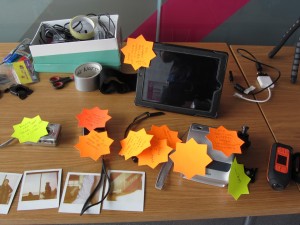
The group gave us an insight into the problems they experience using cameras we wrote their thougts on colour stars on the cameras.
K liked the sound of the Polaroid camera this was felt to be important for those with visual impairment it made it clear when and how many pictures had been taken.
D felt it was important that the Polaroid gave an instant physical result.
P L found the camera too bulky and hard to hold.
The Nikon cool pics camera was liked by the group the camera has a touch screen you can swipe through the images in a similar way to an iPad.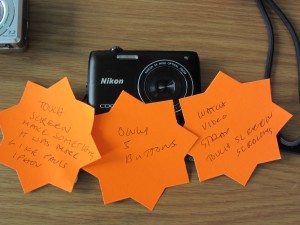
P had a lot of comments about it he liked it because it has one button for video and one for stills P also liked the strap as he was worried about dropping some of the equipment.
A liked the Sony cyber shot because it only had 2 buttons.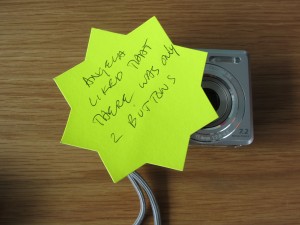
Most of the group liked using the iPad to take photos although some found it difficult to which button to press. 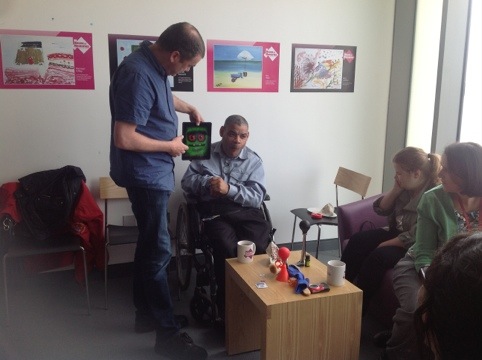
They all enjoyed viewing images on the ipad, it’s big screen and scrolling through the images.
The group found the Sony video camera had too many buttons?
A found the Kodak Flip camera easy to use with its big button but she and E found it hard to review the footage.
We discussed ways we could attach the Drift helmet camera to L’s wheelchair, she enjoyed having the camera held at her eye level by the clamp, and being able to see the screen but it was a bit small. 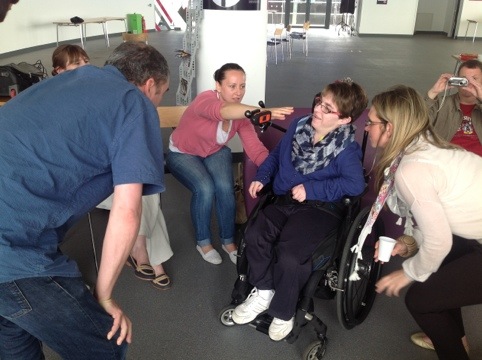
Images taken by the Drift wheel chair mounted camera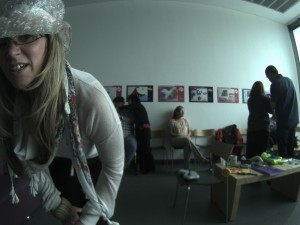
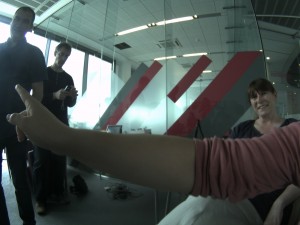
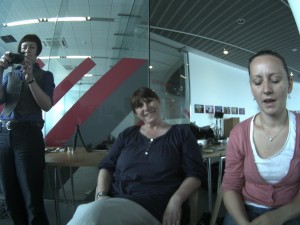
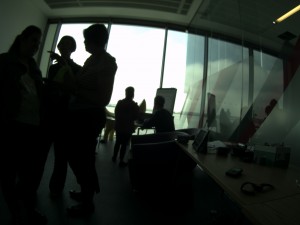
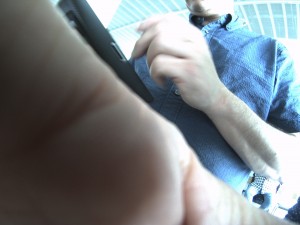
We discussed recording the sound of the poloroid so it could be used as sound on an iPad. We also discussed using a mini printer to have instant digital pics. Nick will make a holder for P to be able to hold the camera with one hand.
Some Additional Thoughts
A summary of the demonstration of sensors at the first Liverpool Museum workshop. Thoughts collectively by Nic and Faustina.
We used only a limited number of sensors to demonstrate some of the things that can be done to bring about changes in sound and visual displays. The intention in this workshop was just to introduce the idea of sensors to participants, and let them ‘play’ with these unfamiliar objects, and see what they do, as it is unlikely they will have come across anything like this before.
Bend sensor
This was limited to making a smiley face smile (or not) by flexing a strip of plastic. Bend it into a ‘U’ shape and the face smiles, but when straight it is neutral. But some participants used the sensor in unexpected ways:
- shaking it, by holding one end
- tapping on the table, by holding one end
- using it with one hand and bending it against the body
- twisting it lengthways
- flexing it in both directions
Perhaps we could extend the range of possibilities of the sensor by allowing for these different ways of using it? One thing that was missing from this sensor was texture – it is currently plain plastic, and smooth to the touch.
Touch sensor
Although the touch sensor was easy to use (didn’t require any explanation other than ‘touch here’) … most people touched it multiple times, or tapped it, and often didn’t notice the change in sound. Part of this might have been because of the volume of background noise (making the sound difficult to hear) and perhaps also because the sounds were changes in instrument.
One or two people ‘stroked’ the touch sensor, which I thought would be a nice modification for the next session. Rather than just touch on/off, a surface which responds to touching, stroking – different forms of stroking behaviour?
Blowing
Not many people tried this as they were distracted by other things (taking pictures). The few who did try this out did not notice the effect of blowing. This might have been because the screen was hard to see, or perhaps also because of the action required, and the resulting animation. I don’t know. It needs a more obvious cue .. perhaps a ‘thing’ to blow into?
A few additional bits … (Nic’s observations)
These are the notes I made when we were collecting the feedback from the participants. Some of the observations will overlap with those above.
Polaroid
People generally liked the sounds made when pressing the button (although it was in a position that made it difficult to use), as it helped to know when you had taken a picture. Having the picture appear right away, and a physical object to handle was liked by most people, though the weight of the camera was a worry – concern about dropping it.
iPad
Generally liked, though a bit big and also concern about dropping it. Liked the big screen, and found the buttons okay, but some people found the capture button difficult to locate.
Sony
Awkward to use and too small. Buttons difficult to use, particularly when using just one hand. On a more positive note, liked the fact it only had two buttons.
Nikon
Easy to use, and easy to watch the videos and find the photos that had been taken, though I didn’t get a good idea of why this was favoured. Liked being able to take pictures by touching screen. (Need more information here.)
Kodak
Simple to take pictures, but other functions were not. Difficult to figure out how to turn on. Hard to find pictures and review videos. Buttons too small.

